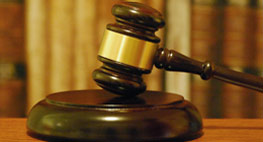Arizona prosecutors ordered to send fake elector case back to grand jury
Supreme Court News
Arizona prosecutors pressing the case against Republicans who are accused of trying to overturn the 2020 election results in President Donald Trump’s favor were dealt a setback when a judge ordered the case be sent back to a grand jury.
Arizona’s fake elector case remains alive after Friday’s ruling by Maricopa County Superior Court Judge Sam Myers, but it’s being sent back to the grand jurors to determine whether there’s probable cause that the defendants committed the crimes.
The decision, first reported by the Washington Post, centered on the Electoral Count Act, a law that governs the certification of a presidential contest and was part of the defendants’ claims they were acting lawfully.
While the law was discussed when the case was presented to the grand jury and the panel asked a witness about the law’s requirements, prosecutors didn’t show the statute’s language to the grand jury, Myers wrote. The judge said a prosecutor has a duty to tell grand jurors all the applicable law and concluded the defendants were denied “a substantial procedural right as guaranteed by Arizona law.”
Richie Taylor, a spokesperson for Arizona Attorney General Kris Mayes, a Democrat whose office is pressing the case in court, said in a statement that prosecutors will appeal the decision. “We vehemently disagree with the court,” Taylor said.
Mel McDonald, a former county judge in metro Phoenix and former U.S. Attorney for Arizona, said courts send cases back to grand juries when prosecutors present misleading or incomplete evidence or didn’t properly instruct panel members on the law.
“They get granted at times. It’s not often,” said McDonald, who isn’t involved in the case.
In all, 18 Republicans were charged with forgery, fraud and conspiracy. The defendants consist of 11 Republicans who submitted a document falsely claiming Trump won Arizona, two former Trump aides and five lawyers connected to the former president, including Rudy Giuliani.
Two defendants have already resolved their cases, while the others have pleaded not guilty to the charges. Trump wasn’t charged in Arizona, but the indictment refers to him as an unindicted coconspirator.
Most of the defendants in the case also are trying to get a court to dismiss their charges under an Arizona law that bars using baseless legal actions in a bid to silence critics.
They argued Mayes tried to use the charges to silence them for their constitutionally protected speech about the 2020 election and actions taken in response to the race’s outcome. Prosecutors said the defendants didn’t have evidence to back up their retaliation claim and that they crossed the line from protected speech to fraud.
Eleven people who had been nominated to be Arizona’s Republican electors met in Phoenix on Dec. 14, 2020, to sign a certificate saying they were “duly elected and qualified” electors and claimed Trump had carried the state in the 2020 election.
President Joe Biden won Arizona by 10,457 votes. A one-minute video of the signing ceremony was posted on social media by the Arizona Republican Party at the time. The document later was sent to Congress and the National Archives, where it was ignored.
Prosecutors in Michigan, Nevada, Georgia and Wisconsin have also filed criminal charges related to the fake electors scheme.
Related listings
-
Judge to weigh Louisiana AG’s challenge to city jail’s ‘sanctuary’ policy
Supreme Court News 05/01/2025Louisiana Attorney General Liz Murrill is pushing forward with her efforts to force Orleans Parish Sheriff Susan Hutson to drop a longtime policy that generally prohibits deputies from directly engaging in federal immigration enforcement within the c...
-
HK defends its immigration procedures after British MP was denied entry
Supreme Court News 04/12/2025Hong Kong’s government on Monday defended its immigration procedures after a British member of parliament was denied entry to the Chinese city last week, an incident that has prompted concerns among U.K. officials.Wera Hobhouse, a member of the...
-
Court sides with the FDA in its dispute over sweet-flavored vaping products
Supreme Court News 04/05/2025The Supreme Court on Wednesday ruled for the Food and Drug Administration in its crackdown on sweet-flavored vaping products following a surge in teen electronic cigarette use.But the justices’ unanimous decision throwing out a federal appeals ...

Workers’ Compensation Subrogation of Administrative Fees and Costs
When a worker covered by workers’ compensation makes a claim against a third party, the workers’ compensation insurance retains the right to subrogate against any recovery from that third party for all benefits paid to or on behalf of a claimant injured at work. When subrogating for more than basic medical and indemnity benefits, the Texas workers’ compensation subrogation statute provides that “the net amount recovered by a claimant in a third‑party action shall be used to reimburse the carrier for benefits, including medical benefits that have been paid for the compensable injury.” TX Labor Code § 417.002.
In fact, all 50 states provide for similar subrogation. However, none of them precisely outlines which payments or costs paid by a compensation carrier constitute “compensation” and can be recovered. The result is industry-wide confusion and an ongoing debate and argument with claimants’ attorneys over what can and can’t be included in a carrier’s lien for recovery purposes.
In addition to medical expenses, death benefits, funeral costs and/or indemnity benefits for lost wages and loss of earning capacity resulting from a compensable injury, workers’ compensation insurance carriers also expend considerable dollars for case management costs, medical bill audit fees, rehabilitation benefits, nurse case worker fees, and other similar fees. They also incur other expenses in conjunction with the handling and adjusting of workers’ compensation claims. Workers’ compensation carriers typically assert, of course, that, they are entitled to reimbursement for such expenditures when it recovers its workers’ compensation lien. Injured workers and their attorneys disagree.

